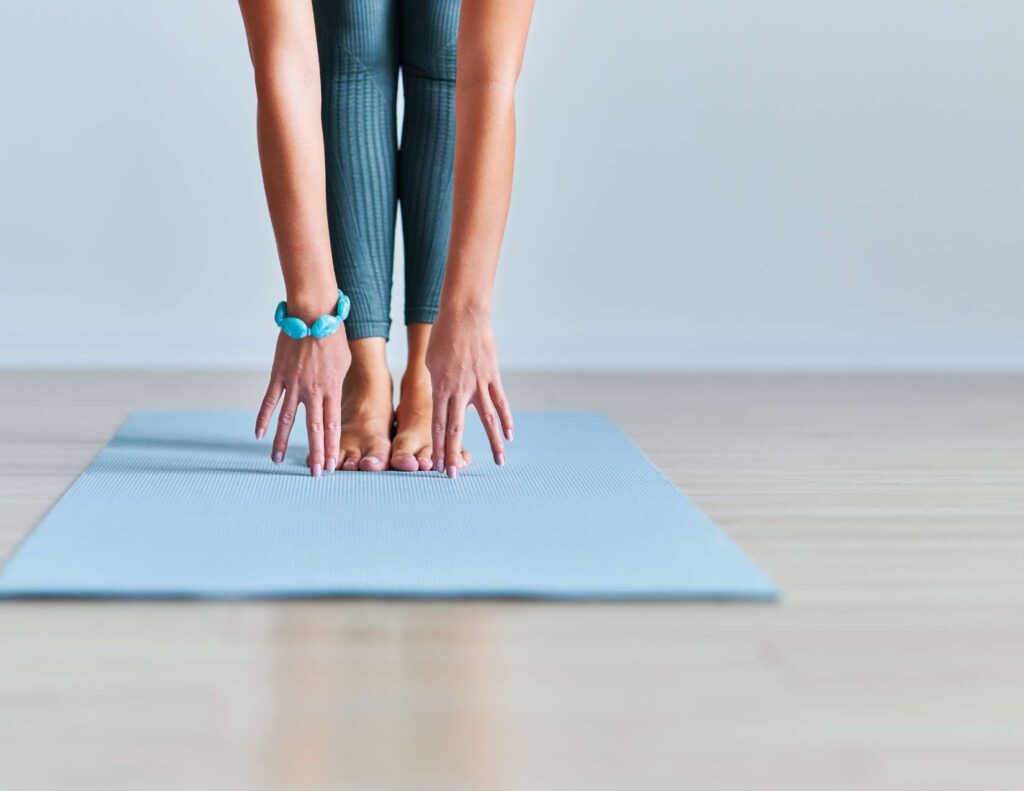17 Top Exercises to Avoid with Plantar Fasciitis
Last Updated on July 25, 2023 by Dr. Tiffany Egan
If you’re dealing with the nagging heel pain of Plantar Fasciitis, you know that every step can feel like a leap of faith. The wrong move could send a jolt of pain throughout your foot. But, that shouldn’t stop you from maintaining an active lifestyle! Knowing which exercises to avoid can be your first step towards healing and pain-free living.
In this article, we will explore 17 exercises to avoid with plantar fasciitis and offer alternatives to keep you moving without the discomfort. Whether you’re a seasoned athlete or simply looking for pain relief, this guide aims to empower you with the knowledge to train smart and live pain-free. Let’s jump in (gently, of course!) and discover the path to healthier, happier feet.
The Top 17 Exercises to Avoid with Plantar Fasciitis are:
1. Running
2. Jumping and hopping
3. High-impact aerobics
4. Step aerobics or plyometrics (jumping exercises)
5. Hill running
6. Burpees
7. Squat jumps or lunges with a jump
8. Box jumps
9. Single leg hops
10. Balance exercises on an unstable surface
11. Barefoot running or walking
12. Exercises that involve pushing off with the toes
13. High-impact dance-based exercises such as Zumba or Hip Hop Abs
14. Isometric calf raises (heel raises) without using a wall for support
15. Calf raises on a step
16. Toe raises
17. Barefoot walking or running on hard surfaces
Table of Contents
What is plantar fasciitis?
Plantar fasciitis is a common foot condition that causes pain and inflammation in the plantar fascia, a thick band of tissue that runs along the bottom of your foot. This painful condition often occurs due to overuse or repetitive strain on the feet, leading to small tears in the plantar fascia. People with plantar fasciitis may experience intense pain in the heel bone or arch of the foot, especially upon taking the first steps in the morning or after long periods of inactivity.
Understanding the causes of plantar fasciitis
Plantar fasciitis is typically caused by excessive stress and strain on the plantar fascia. There are several factors that can increase the risk of developing this condition, including high-impact activities, poor foot mechanics, obesity, wearing improper footwear, pregnancy and postpartum.
Heel pain during pregnancy is very common due to the increased stress on the plantar fascia and Postpartum Foot pain can be caused by biomechanical imbalances, including flat feet. I, personally experienced foot pain, SI joint pain and sciatica during all of my pregnancies and learned for myself what works and what doesn’t.
Also, Individuals who spend long hours on their feet or engage in activities that involve repetitive motions, such as running or jumping, are particularly susceptible to plantar fasciitis.

The importance of exercise for foot health
Regular exercise is crucial for maintaining overall health and well-being, including foot health. Exercise helps to strengthen the muscles, improve flexibility, and maintain a healthy weight. All of which can contribute to preventing foot pain and problems like plantar fasciitis. However, when it comes to individuals with plantar fasciitis, certain exercises should be avoided to prevent further damage and reduce pain.
The Top 17 Exercises to Avoid with Plantar Fasciitis are:
1. Running
2. Jumping and hopping
3. High-impact aerobics
4. Step aerobics or plyometrics (jumping exercises)
5. Hill running
6. Burpees
7. Squat jumps or lunges with a jump
8. Box jumps
9. Single leg hops
10. Balance exercises on an unstable surface
11. Barefoot running or walking
12. Exercises that involve pushing off with the toes
13. High-impact dance-based exercises such as Zumba or Hip Hop Abs
14. Isometric calf raises (heel raises) without using a wall for support
15. Calf raises on a step
16. Toe raises
17. Barefoot walking or running on hard surfaces
Common exercises to avoid with plantar fasciitis
In addition to these exercises to avoid with plantar fasciitis, it’s also a good idea to be mindful of other exercises to avoid if you have sciatica symptoms or low back discomfort. Many times these conditions overlap.
When dealing with plantar fasciitis, it is essential to avoid exercises that put excessive stress and strain on the plantar fascia. Some common exercises to avoid include:
- Running or jogging: Running and jogging can exacerbate the symptoms of plantar fasciitis due to the repetitive impact on the feet. Consider low-impact alternatives such as swimming or cycling.
- Jumping and plyometric exercises: Exercises that involve jumping, such as burpees or box jumps, can put excessive strain on the plantar fascia, worsening the condition.
- High-impact aerobics: High-impact aerobic activities like dance aerobics or step aerobics can lead to increased pain and inflammation in individuals with plantar fasciitis.
Impact exercises to steer clear of
In addition to the common exercises mentioned above, there are several impact exercises that should be avoided by individuals with plantar fasciitis. These exercises can put significant stress on the feet, aggravating the condition and delaying the healing process. It is best to avoid the following impact exercises:
- Tennis: The sudden stops, starts, and lateral movements in tennis can strain the plantar fascia, leading to increased pain and discomfort.
- Basketball: The constant running, jumping, and sudden changes in direction in basketball can be detrimental to individuals with plantar fasciitis.
- Soccer: The quick sprints, abrupt stops, and repetitive kicking involved in soccer can worsen the symptoms of plantar fasciitis.
High-impact sports to be cautious of
While it is advisable to avoid high-impact sports altogether, if you cannot stay away from them, it is crucial to take extra precautions and modify your activities to reduce stress on the feet. Here are some high-impact sports that individuals with plantar fasciitis should approach with caution:
- Running: If running is a part of your regular fitness routine, consider switching to lower-impact alternatives like swimming or using an elliptical machine to minimize the strain on your feet.
- Hiking: Hiking can be strenuous on the feet, especially when traversing uneven terrain. Opt for flatter and less demanding trails or wear supportive footwear and use orthotic inserts to alleviate pressure on the plantar fascia.
- Jumping rope: The repetitive jumping motion involved in jumping rope can aggravate plantar fasciitis. If you must jump rope, do so sparingly and with proper form to minimize the impact on the feet.

Low-impact exercises that are safe for plantar fasciitis
Although high-impact exercises should be avoided, individuals with plantar fasciitis can still engage in low-impact exercises that provide a range of health benefits without exacerbating the condition. When someone asks what cardio exercises can I do with plantar fasciitis? Here are some low-impact exercises that are safe for individuals with plantar fasciitis:
- Swimming: Swimming is an excellent low-impact exercise that provides a full-body workout while minimizing stress on the feet. It helps improve cardiovascular health, muscle strength, and flexibility.
- Cycling: Cycling is a low-impact exercise that can be done indoors or outdoors. It is gentle on the feet and offers cardiovascular benefits while engaging the leg muscles.
- Yoga: Yoga is a low-impact exercise that focuses on stretching, balance, and strengthening. It can help improve flexibility, reduce stress, and promote overall well-being.
- Walking: Running and jogging are not recommended but can you walk for exercise with plantar fasciitis? You bet! Walking is a great way to get your muscles moving, increase circulation in the feet, and reduce inflammation. It’s important to start off slow and increase your walking time as you are comfortable doing so.
Alternative workouts for individuals with plantar fasciitis
If you enjoy a variety of exercises and want to stay active despite having plantar fasciitis, there are alternative workouts that can help you maintain your fitness level without aggravating your foot condition. Here are some alternative workouts for individuals with plantar fasciitis:
- Pilates: Pilates is a low-impact exercise that focuses on core strength, flexibility, and posture. It is gentle on the feet and can be modified to accommodate individuals with plantar fasciitis.
- Water aerobics: Water aerobics is a low-impact workout that takes place in a pool, providing resistance and support. It is an excellent option for individuals with plantar fasciitis as it reduces stress on the feet while offering a cardiovascular workout.
- Resistance training: Incorporating resistance training into your exercise routine can help build strength and muscle tone without putting excessive strain on the feet. Focus on exercises that target the upper body and core.
Stretching exercises to help alleviate plantar fasciitis pain
Stretching exercises can help alleviate pain and improve flexibility in individuals with plantar fasciitis. By stretching the calf muscles and the plantar fascia, you can relieve tension and reduce inflammation. Here are some stretching exercises that can be beneficial for plantar fasciitis:
- Calf stretch: Stand facing a wall with one foot forward and the other foot back, keeping both heels flat on the ground. Lean forward, placing your hands on the wall, and feel the stretch in your calf muscles. Hold for 30 seconds and repeat on the other side.
- Plantar fascia stretch: Sit on a chair and cross one foot over the opposite knee. Grasp your toes and gently pull them back towards your shin until you feel a stretch in the arch of your foot. Hold for 30 seconds and repeat on the other foot.
- Achilles stretch: Stand facing a wall with one foot forward and the other foot back. Bend your front knee and lean towards the wall, keeping your back leg straight. You should feel a stretch in your Achilles tendon. Hold for 30 seconds and repeat on the other side.
I’ve just mentioned 10 exercises for plantar fasciitis that you CAN DO! Hopefully, these exercises can help you take steps towards managing your plantar fasciitis and lead to a better quality of life.

Tips for managing plantar fasciitis while staying active
Managing plantar fasciitis while staying active requires careful attention to your feet and taking necessary precautions to minimize pain and discomfort. Here are some tips to help you manage plantar fasciitis while staying active:
- Choose appropriate footwear: Invest in supportive shoes that provide cushioning and arch support. Avoid high heels, flip-flops, and shoes with minimal support, as they can worsen the symptoms of plantar fasciitis. If you are experiencing sciatica symptoms along with your foot pain, it would be helpful to check out the Best Shoes for Sciatica Relief!
- Use orthotic inserts: Orthotic inserts can provide additional support and cushioning to the arch of the foot, reducing strain on the plantar fascia. Consult with a podiatrist to determine the best type of shoe inserts for your specific needs.
- Apply ice and take breaks: If you experience pain or inflammation during or after exercise, apply ice to the affected area for 15 minutes and take breaks as needed. This can help reduce swelling and relieve pain. A frozen water bottle works great for this!
- Use a tennis ball or golf ball: Rolling a tennis ball or golf ball on the bottom of the foot can help reduce pain, as it massages the arch and releases tension in the plantar fascia. This should be done for 5-10 minutes at a time, up to 3 times per day.
- Wearing night splints: Night splints gently stretch the plantar fascia overnight, which can help reduce morning pain. Talk to your podiatrist about getting a custom pair of night splints made for you. It’s also one of the best ways to keep tight calf muscles stretched out.
- Supplements – Supplements for plantar fasciitis can help with the symptoms. They include glucosamine, chondroitin, and fish oils, which are known to reduce inflammation. Other supplements such as Vitamin C, Zinc, Magnesium and Tumeric can also be helpful in relieving some of the discomfort associated with plantar fasciitis.
Recommended footwear for individuals with plantar fasciitis
Wearing appropriate footwear is crucial for individuals with plantar fasciitis to provide support, cushioning, and stability to the feet. Here are some recommended footwear options for individuals with plantar fasciitis:
- Orthopedic shoes: Orthopedic shoes are designed to provide maximum support and cushioning for the feet. They often feature removable insoles that can be replaced with custom orthotics for added comfort.
- Athletic shoes with arch support: Look for athletic shoes that offer good arch support and cushioning. These New Balance shoes can help distribute pressure evenly and reduce strain on the plantar fascia.
- Shoes with a rocker sole: Shoes with a rocker sole can help reduce the load on the plantar fascia by promoting a more natural gait and acting as a shock absorber.
When to seek medical attention for plantar fasciitis
In most cases, plantar fasciitis can be managed with conservative measures such as rest, ice, stretching, and proper footwear. However, if the pain persists or worsens despite these interventions, it is essential to seek medical attention. Additionally, if you experience severe pain, swelling, or difficulty walking, it is recommended to consult a healthcare professional for a proper diagnosis and treatment plan.

Physical therapy for plantar fasciitis
Physical therapy can be an effective treatment option for individuals with plantar fasciitis. A physical therapist can assess your condition, develop a personalized treatment plan, and guide you through exercises and stretches to alleviate pain and improve foot function. They may also use techniques such as ultrasound, massage, and taping to promote healing and reduce inflammation.
Preventing plantar fasciitis from recurring
Once you have experienced plantar fasciitis, it is essential to take preventive measures to avoid its recurrence. Here are some tips to prevent plantar fasciitis from recurring:
- Gradually increase activity: Avoid sudden increases in activity level, especially high-impact activities. Gradually build up intensity and duration to allow your feet to adjust and strengthen over time.
- Wear supportive footwear: Continue wearing supportive footwear, even when you are not exercising. This will provide constant support and cushioning to the feet, reducing the risk of reinjury.
- Maintain a healthy weight: Excess weight can put additional stress on the feet and worsen plantar fasciitis. Maintain a healthy weight through a balanced diet and regular exercise to reduce the strain on your feet.
Taking care of your feet and preventing injuries
Protecting your feet is crucial for maintaining overall foot health and preventing conditions like plantar fasciitis. By understanding the causes of plantar fasciitis, avoiding certain exercises, and incorporating safe alternatives, you can stay active while minimizing the risk of aggravating your foot condition. Remember to listen to your body, take breaks when needed, and seek medical attention if the pain persists or worsens. With proper care and preventive measures, you can protect your feet and enjoy an active, pain-free lifestyle.






